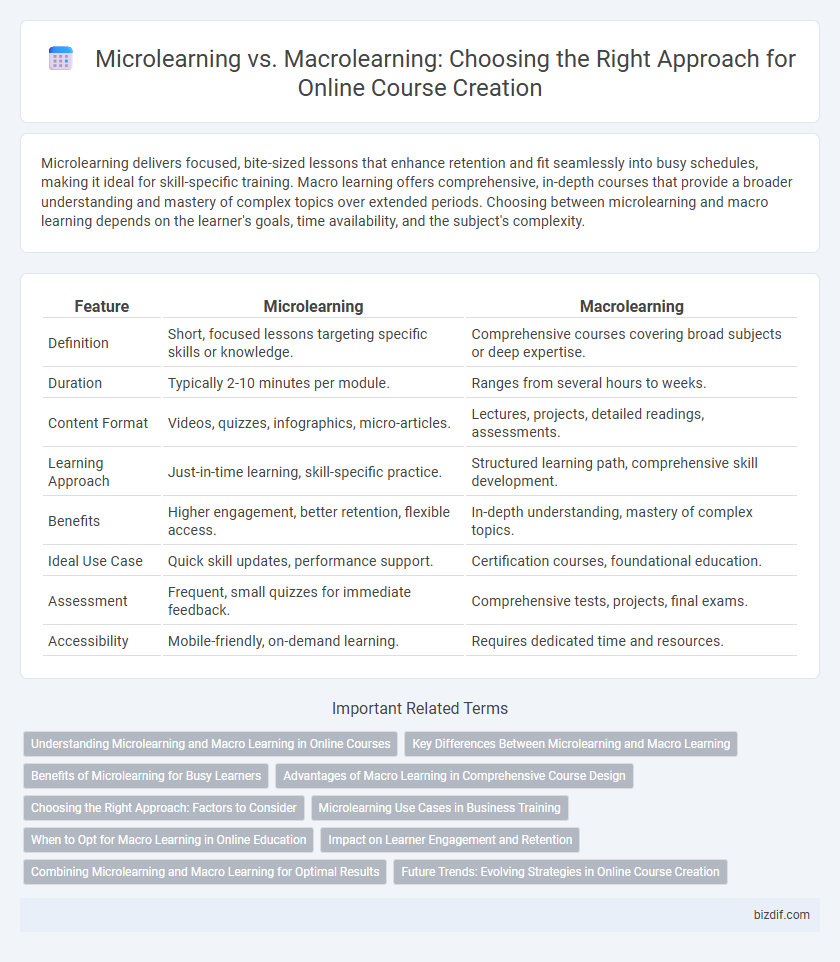Microlearning delivers focused, bite-sized lessons that enhance retention and fit seamlessly into busy schedules, making it ideal for skill-specific training. Macro learning offers comprehensive, in-depth courses that provide a broader understanding and mastery of complex topics over extended periods. Choosing between microlearning and macro learning depends on the learner's goals, time availability, and the subject's complexity.
Table of Comparison
| Feature | Microlearning | Macrolearning |
|---|---|---|
| Definition | Short, focused lessons targeting specific skills or knowledge. | Comprehensive courses covering broad subjects or deep expertise. |
| Duration | Typically 2-10 minutes per module. | Ranges from several hours to weeks. |
| Content Format | Videos, quizzes, infographics, micro-articles. | Lectures, projects, detailed readings, assessments. |
| Learning Approach | Just-in-time learning, skill-specific practice. | Structured learning path, comprehensive skill development. |
| Benefits | Higher engagement, better retention, flexible access. | In-depth understanding, mastery of complex topics. |
| Ideal Use Case | Quick skill updates, performance support. | Certification courses, foundational education. |
| Assessment | Frequent, small quizzes for immediate feedback. | Comprehensive tests, projects, final exams. |
| Accessibility | Mobile-friendly, on-demand learning. | Requires dedicated time and resources. |
Understanding Microlearning and Macro Learning in Online Courses
Microlearning in online courses delivers content in small, focused segments, enhancing learner retention and adaptability by targeting specific skills or concepts. Macro learning encompasses comprehensive lessons or modules that provide in-depth knowledge and broader context, suitable for complex subjects requiring detailed exploration. Effective online course design integrates both microlearning and macro learning strategies to optimize engagement and knowledge retention across diverse learner needs.
Key Differences Between Microlearning and Macro Learning
Microlearning delivers content in small, focused segments designed for quick consumption, ideal for just-in-time training and skill reinforcement. Macro learning involves comprehensive, in-depth courses covering broader topics, suitable for foundational knowledge and complex skill development. Key differences include duration, scope, learner engagement, and application, with microlearning emphasizing brevity and repetition, while macro learning prioritizes extensive understanding and context.
Benefits of Microlearning for Busy Learners
Microlearning offers highly focused and bite-sized content that fits seamlessly into busy schedules, enhancing knowledge retention and minimizing cognitive overload. This approach enables learners to access specific skills or concepts quickly, promoting consistent engagement and improved productivity. Microlearning's adaptability to mobile devices allows on-the-go access, making it an ideal solution for time-constrained professionals seeking efficient educational experiences.
Advantages of Macro Learning in Comprehensive Course Design
Macro learning enables the development of in-depth, comprehensive courses that cover complex subjects systematically. It supports structured progression through large content units, enhancing knowledge retention and mastery in fields such as medicine, law, and engineering. By integrating extensive resources and assessments, macro learning fosters a cohesive educational experience suited for certification and professional development.
Choosing the Right Approach: Factors to Consider
Choosing between microlearning and macro learning depends on learner goals, content complexity, and time availability. Microlearning suits skill-based training requiring short, focused modules, while macro learning is ideal for comprehensive subjects demanding in-depth understanding. Consider learner engagement, retention rates, and delivery platforms to select the most effective course structure.
Microlearning Use Cases in Business Training
Microlearning delivers focused training modules that boost employee retention and engagement by breaking content into bite-sized, easily digestible units. It is highly effective for onboarding new hires, upskilling teams rapidly, and reinforcing compliance knowledge through just-in-time learning. Businesses leverage microlearning to reduce training time and costs while increasing learner motivation and performance.
When to Opt for Macro Learning in Online Education
Macro learning is ideal for comprehensive subjects requiring in-depth understanding and long-term skill development, such as professional certifications or complex technical training. It suits learners who benefit from a structured curriculum, allowing sustained engagement and progressive knowledge building over weeks or months. Opting for macro learning ensures robust content absorption and mastery, crucial for roles demanding advanced expertise and critical thinking.
Impact on Learner Engagement and Retention
Microlearning enhances learner engagement and retention by delivering content in small, focused segments, which reduces cognitive overload and allows for quick knowledge application. Macro learning provides comprehensive, in-depth coverage suited for complex subjects but may risk reduced engagement due to longer attention demands. Tailoring course design to incorporate microlearning elements within broader macro learning frameworks optimizes both engagement and long-term retention.
Combining Microlearning and Macro Learning for Optimal Results
Combining microlearning and macro learning in online course creation enhances knowledge retention and learner engagement by integrating short, focused lessons with comprehensive, in-depth modules. Microlearning delivers targeted content for immediate application, while macro learning provides broader context and skill mastery, ensuring both quick wins and long-term understanding. This blended approach leverages the strengths of each method to optimize cognitive load and adapt to diverse learning preferences.
Future Trends: Evolving Strategies in Online Course Creation
Microlearning emphasizes brief, focused content modules that enhance retention and accommodate modern learners' limited attention spans. Macro learning offers comprehensive, in-depth courses designed for mastery over extended periods, appealing to learners seeking thorough expertise. Future trends in online course creation prioritize adaptive learning technologies that blend micro and macro learning, leveraging AI to customize pathways and optimize engagement based on individual learner needs.
Microlearning vs Macro learning Infographic

 bizdif.com
bizdif.com